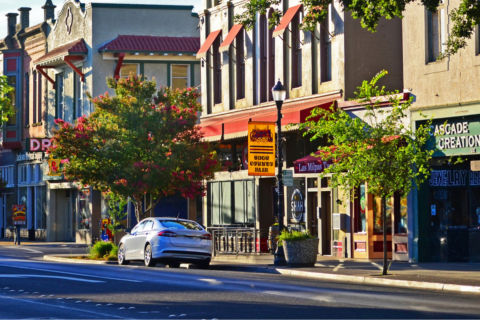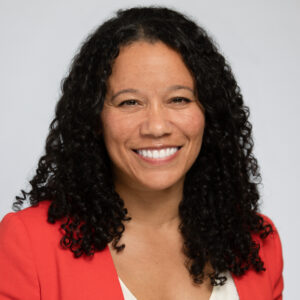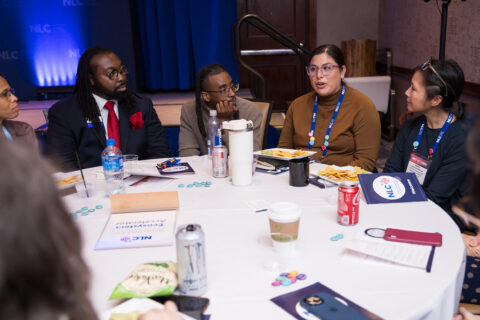Co-authored by Vonnette Harris, Economic Recovery Corps Fellow, President and CEO, Kairos Development and Laura Searfoss, Senior Program Director, Mid-Atlantic Market, Enterprise Community Partners
The 16-mile Purple Line rail network, set to run through Prince George’s and Montgomery counties in Maryland, presents a transformative opportunity for economic growth and improved cross-county transportation. It promises easier access for commuters and increased connectivity between communities. However, alongside these benefits comes a crucial consideration: How will this new transit system affect residents, small businesses and the potential risk of displacement?
This question has shaped the strategic efforts led by the Purple Line Corridor Coalition. Enterprise Community Partners, an Economic Recovery Corps (ERC) host site, is an active partner in the coalition, working to ensure that a community-centered approach remains at the forefront. With the rail line currently slated to open in late 2027, Enterprise Community Partners recognized early on that preserving and improving homes to prevent displacement must remain a top priority for stakeholders, developers and investors alike.
Through a coalition-based approach led by Purple Line Corridor Coalition (PLCC) housed at the National Center for Smart Growth at the University of Maryland, Enterprise Community Partners is helping to elevate housing preservation as a tool for anti-displacement efforts.
NLC Site Visit
A recent site visit by the National League of Cities provided an opportunity to delve deeper into this critical work and learn about the on-the-ground strategies being implemented to protect vulnerable communities while ensuring equitable development. Welcomed by Enterprise Community Partners host Laura Searfoss and ERC fellow Vonnette Harris, NLC’s Entrepreneurship and Economic Development team was offered a comprehensive overview of the landscape and the multifaceted impact of the Purple Line on both residents and small businesses.
Centered on the goal of preventing displacement, the visit featured an activation conference organized by the Housing Association for Nonprofit Developers (HAND), in collaboration with Enterprise Community Partners and the National Center for Smart Growth, titled “Beyond the Tracks: Preventing Displacement in Purple Line Communities.” This curated event emphasized the essential, continued collaboration needed between community stakeholders including residents, tenants, small business owners, government and community development organizations working to preserve neighborhood culture while supporting responsible growth. The conference brought together a diverse panel of stakeholders, including policy officials, field experts including blog co-author Vonnette Harris, ERC Fellow, community members and current investors. This breadth of representation aimed to appeal to potential investors in the corridor and highlight the interconnected roles needed to drive equitable development.
The conference transitioned into a dynamic discussion with NLC staff, Laura and Vonnette, who offered valuable insights into the broader project and Enterprise Community Partners’ deep engagement with the community on housing preservation. Building on their key accomplishments, several actionable takeaways emerged that can be shared with city leaders also working to prevent displacement and stabilize existing properties near transit:
Key Strategies to Prevent Displacement
Identify Gaps and Assets in the Housing Ecosystem
- Interview both property owners and tenants to uncover service and support gaps.
- Identify existing tools and critical resources already available to support property owners and tenants.
- Provide tailored technical assistance based on identified needs.
- Connect stakeholders to critical resources, including legal, financial, and operational support.
Convene Key Stakeholders
The Purple Line Preservation Network, a cross-sector collaboration brings together data, local knowledge and technical assistance to raise awareness about displacement risks through loss of affordable homes through transparent information sharing and problem solving.
Employ a Data-Driven Framework
- Utilize data to pinpoint vulnerable buildings and highlight areas ripe for preservation and intervention within the Purple Line corridor.
- In partnership with Enterprise Community Partners, the National Center for Smart Growth (NCSG) at the University of Maryland has developed an early warning system dataset to assess and communicate risk. This innovative tool serves as a foundation for engaging stakeholders in meaningful discussions, helping them evaluate vulnerabilities to properties, owners and tenants. Additionally, supplemental research conducted by Vonnette has played a crucial role in identifying critical patterns that enhance the effectiveness of the NCSG early warning system, such as common ownership across at-risk properties, ensuring informed decision-making and timely interventions.
- This data serves as a starting point for engaging stakeholders and prioritizing preservation efforts.
Facilitate Knowledge Sharing and Technical Assistance
- Led by Vonnette Harris, the initiative provides hands-on technical assistance to property owners and tenant associations.
- Support includes navigating regulatory or financial challenges and accessing preservation resources.
As the Purple Line gets closer to completion, its promise of connectivity and revitalization must be matched by a commitment to inclusive, community-driven growth. The work spearheaded by the Purple Line Corridor Coalition and actively supported by Enterprise Community Partners serves as a model for safeguarding equity amid large scale infrastructure projects. Through strategic partnerships, data-informed action and community engagement, these efforts emphasize that progress should not come at the expense of those who have called these neighborhoods home. With continued collaboration and investment, the Purple Line can be more than a transit project, it can be a blueprint for equitable development that prioritizes people over displacement.
Racial Equity Bond Markets Resource Bank
Use these bite-size modules to learn how your city can use bond issuance to drive equity and leverage public finance as a powerful tool for change.















